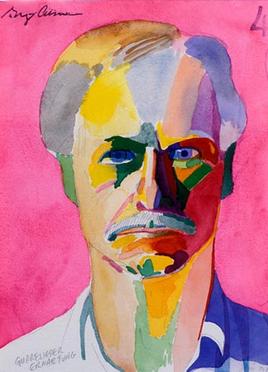
Greg Curnoe was a Canadian painter known for his role in the Canadian art movement labeled London Regionalism, which, beginning in the 1960s, made London, Ontario, an important centre for artistic production in Canada. While his oeuvre chronicled his daily experience in a variety of media, it was grounded in twentieth-century art movements, especially Dada, with its emphasis on nihilism and anarchism, Canadian politics, and popular culture. He is remembered for brightly coloured works that often incorporate text to support his strong Canadian patriotism, sometimes expressed as anti-Americanism, as well as his activism in support of Canadian artists.

John Richard Chambers was an artist and filmmaker. Born in London, Ontario, Chambers' painting style shifted from surrealist-influenced to photo-realist-influenced. He used the term "Perceptual Realism" and later "perceptualism" to describe his style. He began working with film in the 1960s, completing six by 1970. Stan Brakhage proclaimed Chambers' The Hart of London as "one of the greatest films ever made."

The Art Gallery of Ontario is an art museum in Toronto, Ontario, Canada, located in the Grange Park neighbourhood of downtown Toronto, on Dundas Street West. The building complex takes up 45,000 square metres (480,000 sq ft) of physical space, making it one of the largest art museums in North America and the second-largest art museum in Toronto, after the Royal Ontario Museum. In addition to exhibition spaces, the museum also houses an artist-in-residence office and studio, dining facilities, event spaces, gift shop, library and archives, theatre and lecture hall, research centre, and a workshop.
Sadie Coles HQ is a contemporary art gallery in London, owned and directed by Sadie Coles. The gallery focuses on presenting the work of established and emerging international artists. It was at the forefront of the Young British Artists movement.
Gerald Ferguson was a conceptual artist and painter who lived and taught in Halifax, Nova Scotia. Born in Cincinnati he was both a Canadian and US citizen. After receiving his MFA from Ohio University Ferguson taught at two institutions before coming to Canada in 1968, invited to teach at Nova Scotia College of Art and Design (NSCAD) in Halifax. He continued to teach at NSCAD until his retirement in 2006.
Kim Adams is a Canadian sculptor who is known for his assemblages combining prefabricated elements, often parts of cars or other machine-made structures. His visual style is influenced by industrial design, architecture and automotive design. His large-scale sculptures incorporate the model railroading technique of kitbashing, and bright stock colours. They may be shown in a park or street as well as in a museum setting. His small surreal landscapes are toy-sized, and may be installed on shelves.

Canadian art refers to the visual as well as plastic arts originating from the geographical area of contemporary Canada. Art in Canada is marked by thousands of years of habitation by Indigenous peoples followed by waves of immigration which included artists of European origins and subsequently by artists with heritage from countries all around the world. The nature of Canadian art reflects these diverse origins, as artists have taken their traditions and adapted these influences to reflect the reality of their lives in Canada.
Sarindar Dhaliwal is a Canadian multi-media artist, based in Toronto.

London Regionalism is a Canadian art movement that developed in the late 1950s and 1960s in London, Ontario, Canada. Artists in the movement include Greg Curnoe, Tony Urquhart, Murray Favro, Ron Martin and Jack Chambers.
Galerie Max Hetzler is a gallery for contemporary art with locations in Berlin, Paris and London.
Nicole Collins is a contemporary Canadian artist whose work, which takes the form of painting, performance, video, and sound, explores the effect of time, accumulation, force and heat on visceral materials. She currently teaches at OCAD University.
Sara Angelucci is a Canadian artist based in Toronto, Ontario, Canada.
Catinca Tabacaru Gallery is a contemporary art gallery in New York City opened in May 2014. Catinca Tabacaru Gallery, Harare, the Gallery's second location was founded in August 2017 in partnership with Dzimbanhete Arts Interactions.
Ben Portis was a Canadian artist, curator, and critic working in the fields of contemporary art including sound art, performance, music, and architecture.
Jordan Bennett is a multi-disciplinary artist of Mi'kmaq descent from Stephenville Crossing, Newfoundland, also known as Ktaqamkuk. He is married to Métis visual artist Amy Malbeuf.

The Canadian pavilion houses Canada's national representation during the Venice Biennale arts festivals.
Janice Gurney is a Canadian contemporary artist born in Winnipeg, Manitoba. She graduated University of Manitoba in 1973 with a Bachelor of Fine Arts Honours degree and later received a Master of Visual Studies degree from University of Toronto in 2007 with a collaborative degree in Book History and Print Culture. She went on to get a PhD in Art and Visual Culture at Western University in 2012.
John Boyle is a Canadian painter known for his use of subjects drawn from his own specific life experience and from Canadian history. He was a part of the London Regional art movement.
Ron Martin is a Canadian abstract painter. His way of generating his paintings by conceptually defined strategies differs from modernist abstraction, which seeks to enhance an artist's special aesthetic genius and craft skills. Martin works in series.




